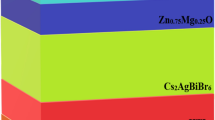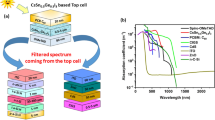Abstract
Lead-free double perovskites are a newly developed category of non-toxic material with impressive photoelectric properties and excellent inherent environmental stability. This study explores the design and performance optimization of lead-free double perovskite/c-Si tandem devices (TDs). Two top cells (TCs) made of \({\text{C}\text{s}}_{4}\text{C}\text{u}\text{S}{\text{b}}_{2}{\text{C}\text{l}}_{12}\) (bandgap of 1.6 eV) and \({\text{C}\text{s}}_{2}\text{A}\text{g}\text{B}\text{i}{\text{B}\text{r}}_{6}\) (bandgap of 2.05 eV) absorber materials and the bottom cell (BC) of c-Si (bandgap of 1.12 eV), have been utilized for designing two TDs. To design an efficient TD’s structure, TC and BC were first individually simulated and calibrated against the findings derived from the reported experimental data. The absorber’s thickness of TC reaches the current matching, when the current it generates under AM 1.5G spectrum matches the BC’s current under a filtered spectrum (generated through TC). At current matching condition, the optimized values of thickness of \({\text{C}\text{s}}_{4}\text{C}\text{u}\text{S}{\text{b}}_{2}{\text{C}\text{l}}_{12}\) and \({\text{C}\text{s}}_{2}\text{A}\text{g}\text{B}\text{i}{\text{B}\text{r}}_{6}\) layers are 0.418 and 1.29 μm, respectively. The lead-free \({\text{C}\text{s}}_{4}\text{C}\text{u}\text{S}{\text{b}}_{2}{\text{C}\text{l}}_{12}/\text{c}-\text{S}\text{i}\) and \({\text{C}\text{s}}_{2}\text{A}\text{g}\text{B}\text{i}{\text{B}\text{r}}_{6}/\text{c}-\text{S}\text{i}\) TDs exhibit a PCE (power conversion efficiency) value of 34.67% (\({\text{V}}_{\text{O}\text{C}}\) = 1.82 V, \({\text{J}}_{\text{S}\text{C}}\) = 20.75 \({\text{m}\text{A}/\text{c}\text{m}}^{2}\), FF = 88.31%) and 36.88% (\({\text{V}}_{\text{O}\text{C}}\) = 2.16 V, \({\text{J}}_{\text{S}\text{C}}\) = 21.105 \({\text{m}\text{A}/\text{c}\text{m}}^{2}\), FF = 79.68%), respectively. Performance parameters of TDs obtained from this work are comparable to the results of reported experiments and simulations. Analysis of this study reveals that enhancing PCE of double-perovskite TC is essential to promise the TD’s benefits. The results reported demonstrate that lead-free and stable double perovskite materials can act as an essential absorber in sub-cells for highly efficient, commercially viable, non-toxic and eco-friendly tandem photovoltaic technologies.
Similar content being viewed by others
Data Availability
No datasets were generated or analysed during the current study.
References
Andreani LC, Bozzola A, Kowalczewski P et al (2019) Silicon solar cells: toward the efficiency limits. Adv Phys X 4:1548305. https://doi.org/10.1080/23746149.2018.1548305
Green MA, Dunlop ED, Siefer G et al (2023) Solar cell efficiency tables (Version 61). Prog Photovoltaics Res Appl 31:3–16. https://doi.org/10.1002/pip.3646
Alharbi FH, Kais S (2015) Theoretical limits of photovoltaics efficiency and possible improvements by intuitive approaches learned from photosynthesis and quantum coherence. Renew Sustain Energy Rev 43:1073–1089. https://doi.org/10.1016/j.rser.2014.11.101
Shockley W, Queisser HJ (1961) Detailed balance limit of efficiency of p-n junction solar cells. J Appl Phys 32:510–519. https://doi.org/10.1063/1.1736034
Zhang C, Gwamuri J, Andrews R, Pearce JM (2014) Design of multijunction photovoltaic cells optimized for varied atmospheric conditions. Int J Photoenergy 2014:1–8. https://doi.org/10.1155/2014/514962
Bremner SP, Levy MY, Honsberg CB (2008) Analysis of tandem solar cell efficiencies under AM1. 5G spectrum using a rapid flux calculation method. Prog Photovoltaics Res Appl 16:225–233. https://doi.org/10.1002/pip.799
Marti A, Araújo GL (1996) Limiting efficiencies for photovoltaic energy conversion in multigap systems. Sol Energy Mater Sol Cells 43:203–222. https://doi.org/10.1016/0927-0248(96)00015-3
Werner J, Niesen B, Ballif C (2018) Perovskite/silicon tandem solar cells: marriage of convenience or true love story?–An overview. Adv Mater Interfaces 5:1700731. https://doi.org/10.1002/admi.201700731
Wang Z, Song Z, Yan Y et al (2019) Perovskite—a perfect top cell for tandem devices to break the S–Q limit. Adv Sci 6:1801704. https://doi.org/10.1002/advs.201801704
Leijtens T, Bush KA, Prasanna R, McGehee MD (2018) Opportunities and challenges for tandem solar cells using metal halide perovskite semiconductors. Nat Energy 3:828–838. https://doi.org/10.1038/s41560-018-0190-4
Lal NN, Dkhissi Y, Li W et al (2017) Perovskite tandem solar cells. Adv Energy Mater 7:1602761. https://doi.org/10.1002/aenm.201602761
Jost M, Kohnen E, Morales-Vilches AB et al (2018) Textured interfaces in monolithic perovskite/silicon tandem solar cells: Advanced light management for improved efficiency and energy yield. Energy Environ Sci 11:3511–3523. https://doi.org/10.1039/c8ee02469c
Islam T, Jani R, Islam AF et al (2021) Investigation of CsSn0.5Ge0.5I3-on-Si tandem solar device utilizing SCAPS simulation. IEEE Trans Electron Devices 68:618–625. https://doi.org/10.1109/TED.2020.3045383
Lakhdar N, Hima A (2020) Electron transport material effect on performance of perovskite solar cells based on CH3NH3GeI3. Opt Mater (Amst) 99:109517. https://doi.org/10.1016/j.optmat.2019.109517
Yu C (2019) Advances in modelling and simulation of halide perovskites for solar cell applications advances in modelling and simulation of halide perovskites for solar cell applications. J Phys Energy 1:022001. https://doi.org/10.1088/2515-7655/aaf143
Raj A, Kumar M, Bherwani H et al (2021) Evidence of improved power conversion efficiency in lead-free CsGeI 3 based perovskite solar cell heterostructure via scaps simulation. J Vac Sci Technol B 39:012401. https://doi.org/10.1116/6.0000718
Diouf B, Muley A, Pode R (2023) Issues, challenges, and future perspectives of perovskites for energy conversion applications. Energies 16:6498. https://doi.org/10.3390/en16186498
Mesquita I, Andrade L, Mendes A (2018) Perovskite solar cells: materials, configurations and stability. Renew Sustain Energy Rev 82:2471–2489. https://doi.org/10.1016/j.rser.2017.09.011
Chen Y, Zhang L, Zhang Y et al (2018) Large-area perovskite solar cells-a review of recent progress and issues. RSC Adv 8:10489–10508. https://doi.org/10.1039/c8ra00384j
Asmontas S, Mujahid M (2023) Recent progress in perovskite tandem solar cells. Nanomaterials 13:1886. https://doi.org/10.3390/nano13121886
Ji F, Boschloo G, Wang F, Gao F (2023) Challenges and progress in lead-free halide double perovskite solar cells. Sol RRL 7:2201112. https://doi.org/10.1002/solr.202201112
Mahajan P, Datt R, Chung Tsoi W et al (2021) Recent progress, fabrication challenges and stability issues of lead-free tin-based perovskite thin films in the field of photovoltaics. Coord Chem Rev 429:213633. https://doi.org/10.1016/j.ccr.2020.213633
Cai T, Shi W, Hwang S et al (2020) Lead-free Cs4CuSb2Cl12 layered double perovskite nanocrystals. J Am Chem Soc 142:11927–11936. https://doi.org/10.1021/jacs.0c04919
Mohandes A, Moradi M, Nadgaran H (2021) Numerical simulation of inorganic Cs2AgBiBr6 as a lead-free perovskite using device simulation SCAPS-1D. Opt Quantum Electron 53:1–22. https://doi.org/10.1007/s11082-021-02959-z
He Y, Xu L, Yang C et al (2021) Design and numerical investigation of a lead-free inorganic layered double perovskite cs4cusb2cl12 nanocrystal solar cell by scaps-1d. Nanomaterials 11:1–19. https://doi.org/10.3390/nano11092321
Yadav SC, Manjunath V, Srivastava A et al (2022) Stable lead-free Cs4CuSb2Cl12 layered double perovskite solar cells yielding theoretical efficiency close to 30%. Opt Mater (Amst) 132:112676. https://doi.org/10.1016/j.optmat.2022.112676
Pindolia G, Shinde SM, Jha PK (2022) Optimization of an inorganic lead free RbGeI3 based perovskite solar cell by SCAPS-1D simulation. Sol Energy 236:802–821. https://doi.org/10.1016/j.solener.2022.03.053
Gamal N, Sedky SH, Shaker A, Fedawy M (2021) Design of lead-free perovskite solar cell using Zn1-xMgxO as ETL: SCAPS device simulation. Optik (Stuttg) 242:167306. https://doi.org/10.1016/j.ijleo.2021.167306
Madani S, Tesfamichael T, Wang H, Motta N (2022) Study of Pb-based and Pb-free perovskite solar cells using Cu-doped Ni1-xO thin films as hole transport material. Ceram Int 48:15207–15217. https://doi.org/10.1016/j.ceramint.2022.02.051
Amri K, Belghouthi R, Aillerie M, Gharbi R (2021) Device optimization of a lead-free perovskite/silicon tandem solar cell with 24.4% power conversion efficiency. Energies 14:3383. https://doi.org/10.3390/en14123383
Kim K, Gwak J, Ahn SK et al (2017) Simulations of chalcopyrite/c-Si tandem cells using SCAPS-1D. Sol Energy 145:52–58. https://doi.org/10.1016/j.solener.2017.01.031
Mashot Jafar A, Khalaph KA, Moula Hmood A (2020) Lead-free perovskite and double perovskite solar cells. IOP Conf Ser Mater Sci Eng 765:1–11. https://doi.org/10.1088/1757-899X/765/1/012047
Loper P, Stuckelberger M, Niesen B et al (2015) Complex refractive index spectra of CH3NH3PbI3 perovskite thin films determined by spectroscopic ellipsometry and spectrophotometry. J Phys Chem Lett 6:66–71. https://doi.org/10.1021/jz502471h
Al-Mousoi AK, Mohammed MKA, Kumar A et al (2023) Understanding auger recombination in perovskite solar cells. Phys Chem Chem Phys 25:16459–16468. https://doi.org/10.1039/d3cp00441d
Madan J, Shivani, Pandey R, Sharma R (2020) Device simulation of 17.3% efficient lead-free all-perovskite tandem solar cell. Sol Energy 197:212–221. https://doi.org/10.1016/j.solener.2020.01.006
Sinha NK, Ghosh DS, Khare A (2022) Role of built-in potential over ETL/perovskite interface on the performance of HTL-free perovskite solar cells. Opt Mater (Amst) 129:112517. https://doi.org/10.1016/j.optmat.2022.112517
Yoshikawa K, Kawasaki H, Yoshida W et al (2017) Silicon heterojunction solar cell with interdigitated back contacts for a photoconversion efficiency over 26%. Nat Energy 2:17032. https://doi.org/10.1038/nenergy.2017.32
Jafarzadeh F, Aghili H, Nikbakht H, Javadpour S (2022) Design and optimization of highly efficient perovskite/homojunction SnS tandem solar cells using SCAPS-1D. Sol Energy 236:195–205. https://doi.org/10.1016/j.solener.2022.01.046
Abdelaziz S, Zekry A, Shaker A, Abouelatta M (2022) Investigation of lead-free MASnI3-MASnIBr2 tandem solar cell: numerical simulation. Opt Mater (Amst) 123:111893. https://doi.org/10.1016/j.optmat.2021.111893
Eperon GE, Stranks SD, Menelaou C et al (2014) Formamidinium lead trihalide: a broadly tunable perovskite for efficient planar heterojunction solar cells. Energy Environ Sci 7:982–988. https://doi.org/10.1039/c3ee43822h
Dastan D, Mohammed MKA, Al-Mousoi AK et al (2023) Insights into the photovoltaic properties of indium sulfide as an electron transport material in perovskite solar cells. Sci Rep 13:1–11. https://doi.org/10.1038/s41598-023-36427-3
Salem MS, Shaker A, Zekry A et al (2021) Analysis of hybrid hetero-homo junction lead-free perovskite solar cells by scaps simulator. Energies 14:1–23. https://doi.org/10.3390/en14185741
Abdelaziz S, Zekry A, Shaker A, Abouelatta M (2020) Investigating the performance of formamidinium tin-based perovskite solar cell by SCAPS device simulation. Opt Mater (Amst) 101:109738. https://doi.org/10.1016/j.optmat.2020.109738
Sengar BS, Garg V, Kumar A, Dwivedi P (2021) Numerical simulation: design of high-efficiency planar p-n homojunction perovskite solar cells. IEEE Trans Electron Devices 68:2360–2364. https://doi.org/10.1109/TED.2021.3066454
Li ZQ, Ni M, Feng XD (2019) Simulation of the Sb2Se3 solar cell with a hole transport layer. Mater Res Express 7:1–9. https://doi.org/10.1088/2053-1591/ab5fa7
Lamanna E, Matteocci F, Calabrò E et al (2020) Mechanically stacked, two-terminal graphene-based perovskite/silicon tandem solar cell with efficiency over 26%. Joule 4:865–881. https://doi.org/10.1016/j.joule.2020.01.015
Al-Ashouri A, Köhnen E, Li B et al (2020) Monolithic perovskite/silicon tandem solar cell with > 29% efficiency by enhanced hole extraction. Science 370:1300–1309. https://doi.org/10.1126/science.abd4016
Benaicha M, Dehimi L, Pezzimenti F, Bouzid F (2020) Simulation analysis of a high efficiency GaInP/Si multijunction solar cell. J Semicond 41:1–6. https://doi.org/10.1088/1674-4926/41/3/032701
Sarker S, Islam MT, Rauf A et al (2021) A SCAPS simulation investigation of non-toxic MAGeI3-on-Si tandem solar device utilizing monolithically integrated (2-T) and mechanically stacked (4-T) configurations. Sol Energy 225:471–485. https://doi.org/10.1016/j.solener.2021.07.057
Dai L, Li S, Hu Y et al (2023) Three-terminal monolithic Perovskite/silicon tandem solar cell exceeding 29% power conversion efficiency. ACS Energy Lett 8:3839–3842. https://doi.org/10.1021/acsenergylett.3c01347
Jung ED, Kim CU, Noh YW et al (2023) Aesthetic and efficient perovskite/Si tandem solar cells using luminescent down-shifting textured anti-reflection films. EcoMat 5:1–11. https://doi.org/10.1002/eom2.12399
Wang Y, Tian H, Zhang D et al (2023) Study on high – efficiency double perovskite / silicon heterojunction tandem cells with sb – doped Cs2AgBiBr6. J Electron Mater 52:7728–7739. https://doi.org/10.1007/s11664-023-10692-4
Acknowledgements
Authors are grateful to the Department of Science and Technology (DST), Govt. of India, for financial backing through DST SERB Project File No. SRG/2021/002110. Dr. Amitesh Kumar acknowledges DST SERB regarding the Start-up Research Grant, fostering research at NIT Patna. Mr. Pritam Kumar expresses gratitude for providing and supporting facilities for research extended by the Department of Electrical Engineering, NIT Patna. Prof. Marc Burgelman from the University of Gent, Belgium, is appreciated for providing the crucial open-source SCAPS-1D software essential to this work.
Funding
Authors are grateful to the Department of Science and Technology (DST), Govt. of India, for financial backing through DST SERB Project File No. SRG/2021/002110.
Author information
Authors and Affiliations
Contributions
PK: Conceptualization, Methodology, Visualization, Investigation, Data curation, Software, Writing-original draft. AK: Conceptualization, Methodology, Formal analysis, Supervision, Reviewing and Editing.
Corresponding author
Ethics declarations
Ethical Approval
Not applicable.
Competing Interests
The authors declare no competing interests.
Additional information
Publisher’s Note
Springer Nature remains neutral with regard to jurisdictional claims in published maps and institutional affiliations.
Rights and permissions
Springer Nature or its licensor (e.g. a society or other partner) holds exclusive rights to this article under a publishing agreement with the author(s) or other rightsholder(s); author self-archiving of the accepted manuscript version of this article is solely governed by the terms of such publishing agreement and applicable law.
About this article
Cite this article
Kumar, P., Kumar, A. Device Engineering of Lead-free Double Perovskite (Cs4CuSb2Cl12 & Cs2AgBiBr6)/Crystalline Silicon High-Performance Eco-friendly Tandem Solar Cells. Silicon (2024). https://doi.org/10.1007/s12633-024-02920-1
Received:
Accepted:
Published:
DOI: https://doi.org/10.1007/s12633-024-02920-1




